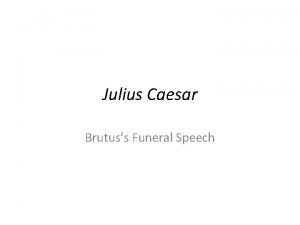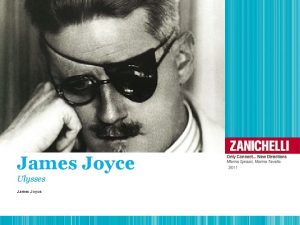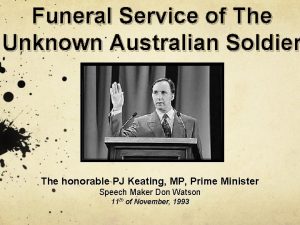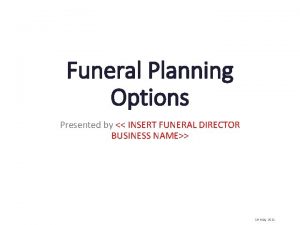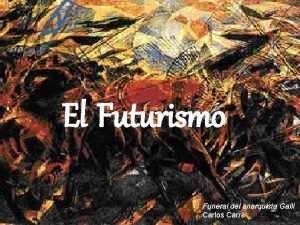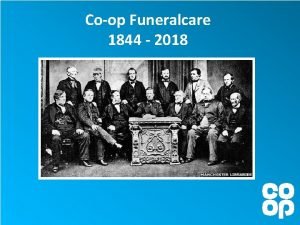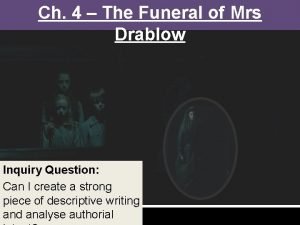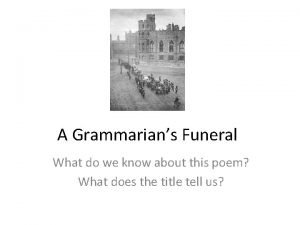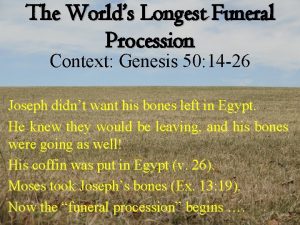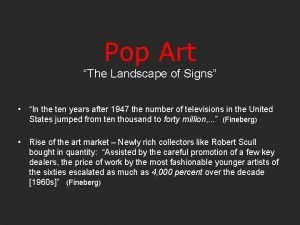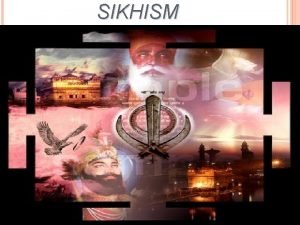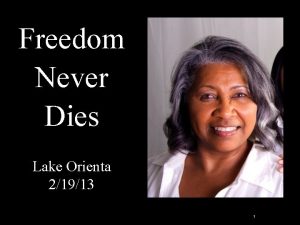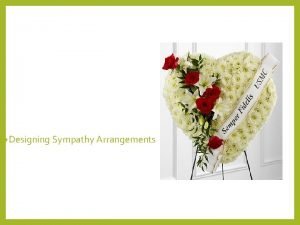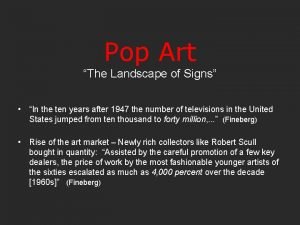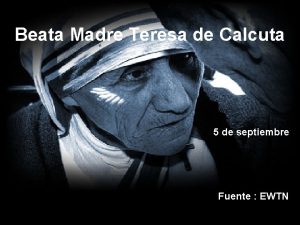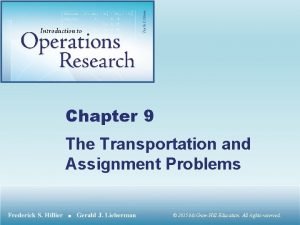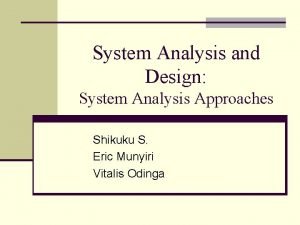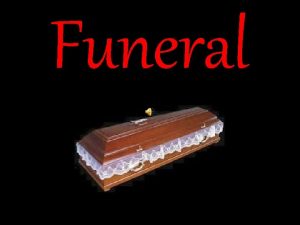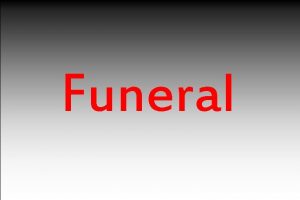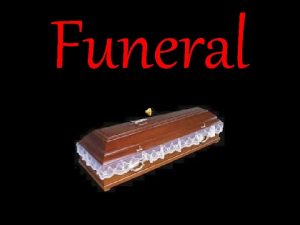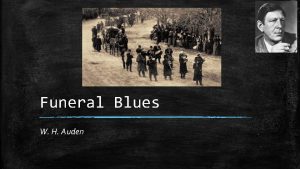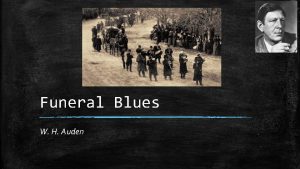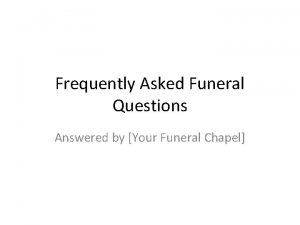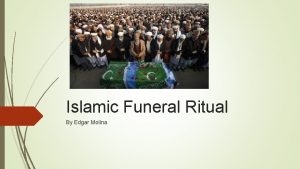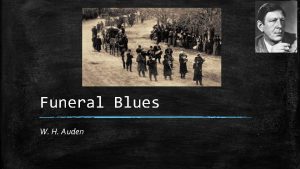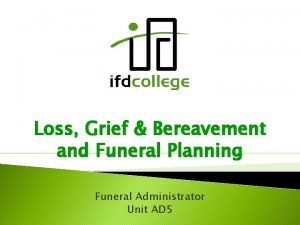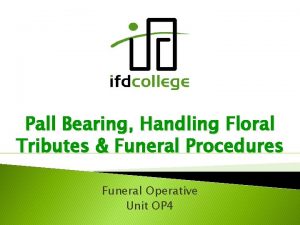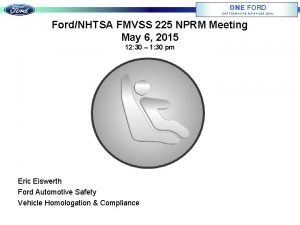CHAPTER 9 Development of Funeral Transportation Transportation One





















































- Slides: 53

CHAPTER 9 Development of Funeral Transportation

Transportation “One of the most inescapable needs created by death is an organized society arises from the fact that the corpse must be moved from the point of death to the other place for preparation then funeralization and interment. ” As you become a funeral director you are faced with this very same problem… What type of vehicle will you use? What will the vehicle look like?

Funeral Procession and the Hearse • So important is the collective act of bearing the dead to the place of sepulture that it has tended historically either to be incorporated into religious organization, or to come under religious control. • Of all processions, the funeral procession is the oldest.

Funeral Procession and the Hearse • The procession starts at a period antedating wheeled vehicles, and it has continued down to the present. The character and form of the procession, or to use the modern term, the funeral varies widely in different countries. Regardless of variety, it is one of the most universal acts. • The word "funeral" is derived from funeralis, the Latin Word for “torchlight procession. ”

Funeral Procession and the Hearse • One of the standard pieces of equipment and the most common symbol of the funeral procession has been the hearse or the… Funeral Coach

Funeral Procession and the Hearse • Origins of the word hearse – French is herse. – Latin is hirpex- meaning a rake or harrow. – The first hearse looked like a huge rectangle rake with the teeth or prongs pointing upward. – Remember the plumes on the casket? – What did they stand for?

Funeral Procession and the Hearse • Hearses were also used to enclose the tomb or grave… – A hearse used to the grave you ask? ? ? enclose

Funeral Procession and the Hearse • As burial moved away from the churches and churchyards the need for better transportation became pinnacle to the funeral functionaries. • This provided the “bearing”, by hand or shoulder carrying to be the birth point of the modern day hearse.

Funeral Procession and the Hearse • The simple forerunner of the hearse was the bier or the “bear”. – Similar to a hand-stretcher on which an uncoffined body was carried to the grave.

Funeral Procession and the Hearse As coffins were brought into popular use they were likewise born on the bier; but the additional weight, especially in the case of lined or multiple coffins, necessitated an adaptation for the problem of long distances. One solution was to have two sets of “bearers”. Four of the oldest or most prominent men were called “bearers”; another four, whose duty it was to relieve the bearers, were called “Underbearers. ”

Funeral Procession and the Hearse • The first instance of a hearse on wheels is found in the burial of Colonel Rainsborowe in 1648. • By 1690 the hearse had become a necessity in England. Where the London Gazette advertised “Hearses for hire”. • From this point forward until about the mid 19 th Century “hearse” and “bier” were commonly interchangeable.

Funeral Procession and the Hearse • Because the roads leading out from early towns and villages were often narrow, rough and muddy the early hearses were small and functional rather than elaborate, barely held had the room for the casket and the driver. • The driver may have to even sit on or straddle the casket. Would you ever send the hearse out to a funeral with rain spots or mud on the fenders? Cracked windshield or broken tail-lights?

Funeral Procession and the Hearse • Colonial hearses for the wealthy were horse drawn wagons pulled with Six Horses. • But most people still went to the grave on foot. • Horse-drawn hearses became more widely used in the middle 19 th and early 20 th century (1850 -1910).

Funeral Procession and the Hearse • The making of gentleman’s coaches involved considerable skill. It was said that coachmaking was an urban luxury craft: “One of the most spectacular symbols of colonial affluence and gentility was a gentlemen’s carriage and, as men grew richer in town and country the business of coachmaking prospered. ”

Funeral Procession and the Hearse • Many other functionaries became involved in the making of the hearses. • Now that you have the hearses where do you get the horses to pull it? • You are correct…. The livery men started to become more involved with undertaking. – Just as the cabinet makers and upholsters became involved with caskets livery men became involved with the introduction of the hearse.

Hearses with Horses • Until the outbreak of the Civil War, hearses were modeled all about the same. • In about 1861 fashion was beginning to play a more important role in funeral equipage. • From about 1860 forward styles in hearses changed with cyclical regularity at intervals of about every 15 years. What is your opinion of a funeral home that uses a hearse that is outdated?

Hearses with Horses • The hearses before the Civil War were basically a long, rectangle box with windows along the side of French Glass and skimped curtains and room for only one horse and the driver’s seat. • After the Civil War, the hearse became longer and higher, with full plate glass sides, fancy scroll-work along the top, metal columns and a scrolled iron neck for the driver to sit on.

Hearses with Horses

Innovators of the Hearse • James Cunningham- exhibited at the New Orleans Cotton Exposition in 1884 featuring a funeral car. (See plate 51 on page 239). • Shortly after the war, hearses for children came into use and the beautiful white child’s hearse of the Stein Patent Burial Casket Works met with immediate popular approval. • Throughout the last quarter of the 19 th century children’s hearses were standard equipment for all undertakers and funeral directors.

Innovators of the Hearse • Hudson Samson- In 1889 he introduced a new style which was oval decked eight-postered and six columns. • In 1893, Crane & Breed-Exhibited a funeral car at the Chicago World Fair. Designed for West Indian and South American Trade.

Innovators of the Hearse • It included extraordinary size; church-like design; massive carvings in bass-relief; gildings; heavy gold fringes and tassels; and lamps of gold weighing 2400 lbs. (opposed to avg. 1600 lbs. ) It was laden with golden angels and cherubs; crucifixes and statues; a processional scene over the middle glass in which the Saviour was depicted bearing the cross and receded by the two thieves; the two Mary’s, a throng of Roman soldiers and others. Other sculptures over the quarter lights showed the adoration of the Christ child and the Ascension.

Innovators of the Hearse • The hearse was not sent to South America immediately, it was used in the funeral of assassinated Mayor Carter H. Harrison of Chicago. • Later it did make its way to Havana, Cuba where for many years it was used in State Funerals.

• In 1898 Hudson Samson, one of Americas most famous inventors in funeral fashions, proposed the most radical change in funeral car design to ever find its way into general use. • He proposed a hearse that was “entirely obscured by graceful draped imitation of cloth - an immense pall, held up in place by cords and tassels so as to form the draperies, the whole to be carved out of solid wood. • This hearse was considered the greatest triumph ever achieved in the art of hearse making and sold for an estimated $4, 000.



Funeral Trolleys? • With the development of gas powered vehicles and the electric streetcars the stage was set…. • What was the next hearse style? Funeral Trolley Car • It was only big enough to carry the casket, undertaker and bearers • Additional vehicles were provided for the flowers, and mourners. (See plate 53 on page 243).

Funeral Trolleys?

Funeral Trolleys? What do you think were some of the problems with the “Funeral Trolly? ” • People didn’t like it because: – Iron wheels creeked and screeched on turns – Rumbled and bounced through intersections – It was thought of “shooting through the streets at a high rate of speed. ” Do you think that the hearse should have a “solemn speed? ”

Introduction of the Gas Buggy • Design of the gasoline-powered hearses – Fred Hulberg in 1896 designed a hearse 16 ft. long and costing $6000. – It was a truck-like vehicle with passenger section and a rectangle container directly above the motor for the casket. – There is no record if any were actually produced or placed in operation. (See plate 55 on page 248. )

Introduction of the Gas Buggy

Introduction of the Gas Buggy • Crane & Breed- June 1909 they had an autohearse on the market. (See plate 56 on page 249. )

Introduction of the Gas Buggy • Design of the gasoline-powered hearses – Crane & Breed- June 1909 they had an auto-hearse on the market. (See plate 56 on page 249. ) • It was enclosed, painted black with little decoration to it except a rather grotesque replica of the famous tomb of Scipio carved in wood atop the otherwise flat roof of the rectangular coach. For-posted, wood carved, draped window, horse drawn funeral car, still keeping however with the “Scipio” motif. – It was even conceived that undertaker may even use a bicycle to transport the body to the grave.

Introduction of the Gas Buggy • There was a definite argument of the nonfeasibility of the “auto-funeral. ” 1. 2. 3. 4. 5. Would involve a high outlay of cash. Auto hearses could go no faster than horse drawn hearses. Upkeep and the cost of trained chauffeurs would be excessive. The cost of operation would be so high that undertakers would have to cut costs on some other item…. the casket. It seemed like the undertakers were rushing the families to the grave. The older people wanted a slow and leisurely , and more dignified trip to the cemetery.

Introduction of Other Automobiles • Ambulance • Undertaker’s buggy • Limousine • Between 1910 and 1920 the automobile came to dominate the field of funeral transportation, and eventually replaced all other types of vehicles used in funeral service.

Introduction of Other Automobiles • Through World War 1 auto hearses tended to become increasingly more ornate. – One company even marketed a hearse on the body of which was a statue of Gabriel blowing his horn. Does it take away from the funeral to use a hearse with the “statues of Gabriel blowing his horn? ”

Introduction of Other Automobiles • Though patents were granted as early as 1901, it was not until after World War 1 that limousine hearses made their appearance. • Tiring of ornately carved vehicles, funeral directors and the public turned toward the longer smoother lines of the limousine. • Limousine hearses mark the beginning of the tendency toward the blending of the hearse and other conveyances in the funeral procession in pleasing style.

Introduction of Other Automobiles What are some of the pros and cons of the limousine or family car? Do they have a place in funeral processions of today?

Hearses • The side servicing feature in hearses was introduced in 1926. This innovation has added the convenience and dignity of the funeral service as it makes possible loading the vehicle without the necessity of the pallbearers’ walking into the street, as it was sometimes muddy and dirty.

• Sizes and Colors Hearses – Until the civil war hearses were black – After the war they were varied sometimes gray but mostly a dark color. – The size increased in length and width after the war. • Children’s hearses – Nearly always white – Introduced about a decade after the civil war Why is white always associated with children?

• Sizes and Colors Hearses – The most popular color combinations was the basic black hearse with fine lines of silver or gold. – Light grey however became a favorite for carved hearses.

• Flower cars Hearses – Developed for the transportation of the flowers. – Regular hearses with special trays or receptacles attached to the sidewalls of the hearse body above the casket.

Development of Funeral Cars Throughout the 20 th Century Is it unacceptable to transport flowers in the hearse tot eh cemetery placed around the casket? What it the casket is draped with a flag?

Development of Funeral Cars Throughout the 20 th Century • • Hearses Limousines Flower Cars What is the modern term for a hearse today?

Development of Funeral Cars Throughout the 20 th Century • The automobile effected a great change in the life of the individual, so has the development of the motor hearse, with its constant technological developments, helped to revolutionize the burial of the dead. • The funeral director’s responsibilities to the mourners, in terms of both safety and sentiment, likewise grew apace with the growth of his function in directing transportation.

Development of Funeral Cars Throughout the 20 th Century • To organize and direct a procession which must be profoundly ceremonial, which cannot be rehearsed or repeated, and in which mistakes are always magnified by a high level of emotional intensity, defines and fixes responsibility which by conventional standards of occupational recognition elevates the funeral director’s work above and beyond that of the craftsman, tradesman, or purveyor of petty personal services.

Development of Funeral Cars Throughout the 20 th Century

Development of Funeral Cars Throughout the 20 th Century

Development of Funeral Cars Throughout the 20 th Century

Development of Funeral Cars Throughout the 20 th Century

Development of Funeral Cars Throughout the 20 th Century

Development of Funeral Cars Throughout the 20 th Century

Development of Funeral Cars Throughout the 20 th Century

Development of Funeral Cars Throughout the 20 th Century
 One empire one god one emperor
One empire one god one emperor One one little dog run
One one little dog run One king one law one faith
One king one law one faith Byzantine definition
Byzantine definition One ford
One ford See one do one teach one
See one do one teach one One price policy
One price policy Night structure
Night structure Studiendekanat uni bonn
Studiendekanat uni bonn Asean tourism strategic plan
Asean tourism strategic plan Graphic organizer with the aims of la liga filipina
Graphic organizer with the aims of la liga filipina Chapter 10 physical development from one to three
Chapter 10 physical development from one to three Ariasmr
Ariasmr Anaphora in brutus speech
Anaphora in brutus speech The funeral joyce analysis
The funeral joyce analysis At the funeral mark twain analysis
At the funeral mark twain analysis Tone of i felt a funeral in my brain
Tone of i felt a funeral in my brain Truncated sentences examples
Truncated sentences examples Foresters funeral fund
Foresters funeral fund Anarquista galli
Anarquista galli Co op funeral urns
Co op funeral urns Mrs drablow
Mrs drablow A gramamrians funeral
A gramamrians funeral Diploma in funeral arranging and administration
Diploma in funeral arranging and administration Diploma in funeral arranging and administration
Diploma in funeral arranging and administration Diploma in funeral arranging and administration
Diploma in funeral arranging and administration World's longest funeral
World's longest funeral Ed kienholz funeral
Ed kienholz funeral Night funeral in harlem analysis
Night funeral in harlem analysis Dostoevsky funeral
Dostoevsky funeral Rajdeep kaur death reason
Rajdeep kaur death reason Ludi troiani
Ludi troiani Nac sa mis
Nac sa mis Lady dai xin zhui
Lady dai xin zhui Their eyes were watching god ch 9 summary
Their eyes were watching god ch 9 summary Karakia for meeting
Karakia for meeting Burton's funeral home
Burton's funeral home Inset piece funeral
Inset piece funeral Uncle rudi
Uncle rudi Funeral madre teresa de calcuta
Funeral madre teresa de calcuta Robert burgess funeral directors
Robert burgess funeral directors Transportation and assignment problems and solutions
Transportation and assignment problems and solutions Community development definition
Community development definition Development that ended much development crossword
Development that ended much development crossword Development of a truncated cylinder
Development of a truncated cylinder Jose rizal childhood
Jose rizal childhood One shortcoming of rapid application development (rad) is
One shortcoming of rapid application development (rad) is By one man sin
By one man sin One direction songs with alliteration
One direction songs with alliteration How many ones in 40
How many ones in 40 Othello act summaries
Othello act summaries One team, one fight definition
One team, one fight definition One goal one passion
One goal one passion One gene one polypeptide
One gene one polypeptide













